The Role of HRM in the Sports Industry: Opportunities & Challenges
VerifiedAdded on 2020/09/09
|13
|4232
|347
Essay
AI Summary
This essay provides a comprehensive overview of Human Resource Management (HRM) within the sports industry. It begins by highlighting the importance of HRM in achieving organizational goals and maintaining a competitive edge, emphasizing the need for skilled professionals in various areas. The essay then delves into the core components of HRM, including recruitment, training, compensation, and performance analysis, along with managerial functions such as planning, organizing, staffing, leading, and controlling. It also explores the challenges faced in hiring, such as the impact of technology, attrition, and the need to address urgent hiring needs and global workforce management. The paper supports its arguments with both statistical and theoretical data, offering insights into effective HRM practices and strategies for success in the dynamic sports environment.
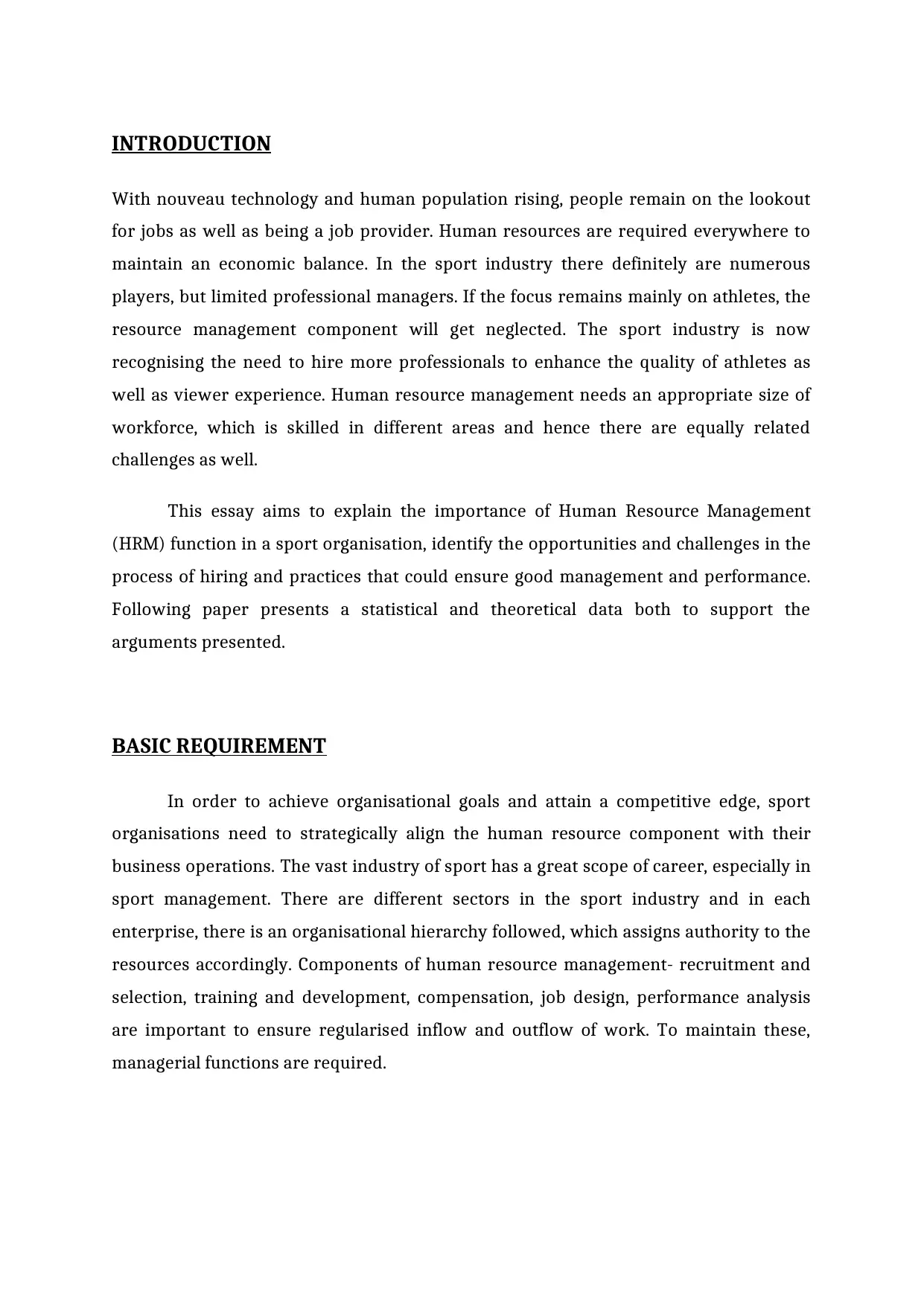
INTRODUCTION
With nouveau technology and human population rising, people remain on the lookout
for jobs as well as being a job provider. Human resources are required everywhere to
maintain an economic balance. In the sport industry there definitely are numerous
players, but limited professional managers. If the focus remains mainly on athletes, the
resource management component will get neglected. The sport industry is now
recognising the need to hire more professionals to enhance the quality of athletes as
well as viewer experience. Human resource management needs an appropriate size of
workforce, which is skilled in different areas and hence there are equally related
challenges as well.
This essay aims to explain the importance of Human Resource Management
(HRM) function in a sport organisation, identify the opportunities and challenges in the
process of hiring and practices that could ensure good management and performance.
Following paper presents a statistical and theoretical data both to support the
arguments presented.
BASIC REQUIREMENT
In order to achieve organisational goals and attain a competitive edge, sport
organisations need to strategically align the human resource component with their
business operations. The vast industry of sport has a great scope of career, especially in
sport management. There are different sectors in the sport industry and in each
enterprise, there is an organisational hierarchy followed, which assigns authority to the
resources accordingly. Components of human resource management- recruitment and
selection, training and development, compensation, job design, performance analysis
are important to ensure regularised inflow and outflow of work. To maintain these,
managerial functions are required.
With nouveau technology and human population rising, people remain on the lookout
for jobs as well as being a job provider. Human resources are required everywhere to
maintain an economic balance. In the sport industry there definitely are numerous
players, but limited professional managers. If the focus remains mainly on athletes, the
resource management component will get neglected. The sport industry is now
recognising the need to hire more professionals to enhance the quality of athletes as
well as viewer experience. Human resource management needs an appropriate size of
workforce, which is skilled in different areas and hence there are equally related
challenges as well.
This essay aims to explain the importance of Human Resource Management
(HRM) function in a sport organisation, identify the opportunities and challenges in the
process of hiring and practices that could ensure good management and performance.
Following paper presents a statistical and theoretical data both to support the
arguments presented.
BASIC REQUIREMENT
In order to achieve organisational goals and attain a competitive edge, sport
organisations need to strategically align the human resource component with their
business operations. The vast industry of sport has a great scope of career, especially in
sport management. There are different sectors in the sport industry and in each
enterprise, there is an organisational hierarchy followed, which assigns authority to the
resources accordingly. Components of human resource management- recruitment and
selection, training and development, compensation, job design, performance analysis
are important to ensure regularised inflow and outflow of work. To maintain these,
managerial functions are required.
Paraphrase This Document
Need a fresh take? Get an instant paraphrase of this document with our AI Paraphraser
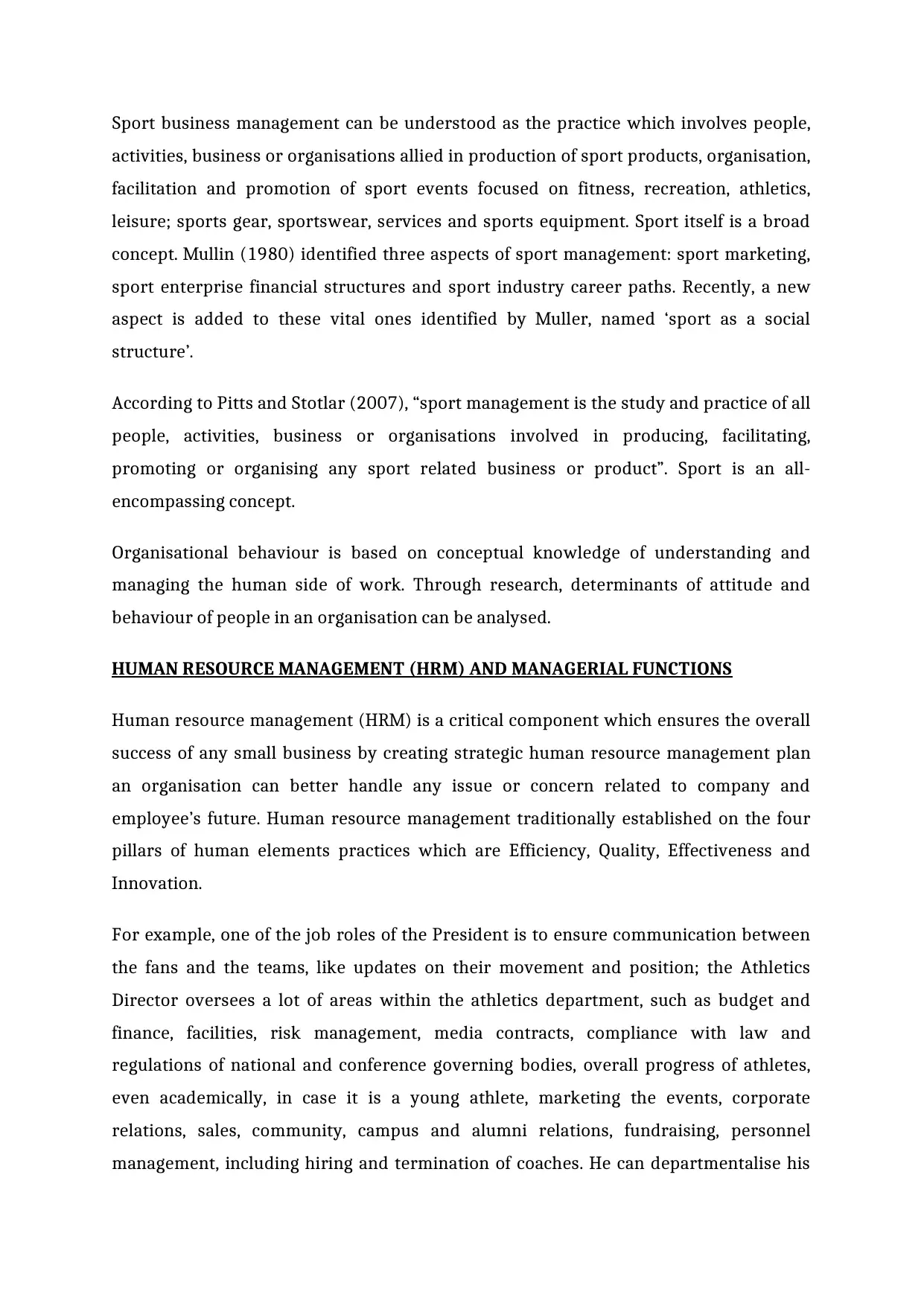
Sport business management can be understood as the practice which involves people,
activities, business or organisations allied in production of sport products, organisation,
facilitation and promotion of sport events focused on fitness, recreation, athletics,
leisure; sports gear, sportswear, services and sports equipment. Sport itself is a broad
concept. Mullin (1980) identified three aspects of sport management: sport marketing,
sport enterprise financial structures and sport industry career paths. Recently, a new
aspect is added to these vital ones identified by Muller, named ‘sport as a social
structure’.
According to Pitts and Stotlar (2007), “sport management is the study and practice of all
people, activities, business or organisations involved in producing, facilitating,
promoting or organising any sport related business or product”. Sport is an all-
encompassing concept.
Organisational behaviour is based on conceptual knowledge of understanding and
managing the human side of work. Through research, determinants of attitude and
behaviour of people in an organisation can be analysed.
HUMAN RESOURCE MANAGEMENT (HRM) AND MANAGERIAL FUNCTIONS
Human resource management (HRM) is a critical component which ensures the overall
success of any small business by creating strategic human resource management plan
an organisation can better handle any issue or concern related to company and
employee’s future. Human resource management traditionally established on the four
pillars of human elements practices which are Efficiency, Quality, Effectiveness and
Innovation.
For example, one of the job roles of the President is to ensure communication between
the fans and the teams, like updates on their movement and position; the Athletics
Director oversees a lot of areas within the athletics department, such as budget and
finance, facilities, risk management, media contracts, compliance with law and
regulations of national and conference governing bodies, overall progress of athletes,
even academically, in case it is a young athlete, marketing the events, corporate
relations, sales, community, campus and alumni relations, fundraising, personnel
management, including hiring and termination of coaches. He can departmentalise his
activities, business or organisations allied in production of sport products, organisation,
facilitation and promotion of sport events focused on fitness, recreation, athletics,
leisure; sports gear, sportswear, services and sports equipment. Sport itself is a broad
concept. Mullin (1980) identified three aspects of sport management: sport marketing,
sport enterprise financial structures and sport industry career paths. Recently, a new
aspect is added to these vital ones identified by Muller, named ‘sport as a social
structure’.
According to Pitts and Stotlar (2007), “sport management is the study and practice of all
people, activities, business or organisations involved in producing, facilitating,
promoting or organising any sport related business or product”. Sport is an all-
encompassing concept.
Organisational behaviour is based on conceptual knowledge of understanding and
managing the human side of work. Through research, determinants of attitude and
behaviour of people in an organisation can be analysed.
HUMAN RESOURCE MANAGEMENT (HRM) AND MANAGERIAL FUNCTIONS
Human resource management (HRM) is a critical component which ensures the overall
success of any small business by creating strategic human resource management plan
an organisation can better handle any issue or concern related to company and
employee’s future. Human resource management traditionally established on the four
pillars of human elements practices which are Efficiency, Quality, Effectiveness and
Innovation.
For example, one of the job roles of the President is to ensure communication between
the fans and the teams, like updates on their movement and position; the Athletics
Director oversees a lot of areas within the athletics department, such as budget and
finance, facilities, risk management, media contracts, compliance with law and
regulations of national and conference governing bodies, overall progress of athletes,
even academically, in case it is a young athlete, marketing the events, corporate
relations, sales, community, campus and alumni relations, fundraising, personnel
management, including hiring and termination of coaches. He can departmentalise his

work by further delegating responsibilities to other staff members, such as marketing
director, who would be responsible to chalk out clever plans to assure full presence and
appreciation of participants as well as the onlookers, sales, human resources,
production, Research and Development and so on. Managers and assistant managers of
different departments (Managers in sport organisation have different responsibilities in
different arenas, such as obtaining financial support, purchasing and maintaining
equipment, furnishing entertainment and lodging for VIPs and being accountable for the
finances being invested). In a manufacturing company, the lowest level is shop floor
workers. The most important skill for managers is critical thinking in order to make
sound decisions.
There are 5 basic managerial functions in human resource management
Planning
Organisations have to make strategic plans to ameliorate its functioning. These plans
could be to change or revamp products/services or to amend the organisational
structure. Strategic planning enables the organisation to achieve its objectives by
formulating, implementing and evaluating anticipated decisions.
(Pumerantz, 2019) For example of decision making plus good marketing skills is of NFL
Sunday Ticket. It is an out-of-market sports’ package that broadcasts National Football
League (NFL) regular season games unavailable on local affiliates. Fans that are unable
to view their team live because of distance barrier or because they like a team which is
not so popular in their region, ideally go for NFL Sunday Tickets. The package is
distributed in different countries through various streaming services and cable
providers.
Organizing
It determines productive ways to cluster activities and human, time and monetary
resources. It is the prime function of managers in any organisation to build a methodical
framework for profitable output. There are four main managerial functions namely
Identification of activities, departmentalisation of activities, classification of authority
and coordination between authority and responsibility.
director, who would be responsible to chalk out clever plans to assure full presence and
appreciation of participants as well as the onlookers, sales, human resources,
production, Research and Development and so on. Managers and assistant managers of
different departments (Managers in sport organisation have different responsibilities in
different arenas, such as obtaining financial support, purchasing and maintaining
equipment, furnishing entertainment and lodging for VIPs and being accountable for the
finances being invested). In a manufacturing company, the lowest level is shop floor
workers. The most important skill for managers is critical thinking in order to make
sound decisions.
There are 5 basic managerial functions in human resource management
Planning
Organisations have to make strategic plans to ameliorate its functioning. These plans
could be to change or revamp products/services or to amend the organisational
structure. Strategic planning enables the organisation to achieve its objectives by
formulating, implementing and evaluating anticipated decisions.
(Pumerantz, 2019) For example of decision making plus good marketing skills is of NFL
Sunday Ticket. It is an out-of-market sports’ package that broadcasts National Football
League (NFL) regular season games unavailable on local affiliates. Fans that are unable
to view their team live because of distance barrier or because they like a team which is
not so popular in their region, ideally go for NFL Sunday Tickets. The package is
distributed in different countries through various streaming services and cable
providers.
Organizing
It determines productive ways to cluster activities and human, time and monetary
resources. It is the prime function of managers in any organisation to build a methodical
framework for profitable output. There are four main managerial functions namely
Identification of activities, departmentalisation of activities, classification of authority
and coordination between authority and responsibility.
⊘ This is a preview!⊘
Do you want full access?
Subscribe today to unlock all pages.

Trusted by 1+ million students worldwide
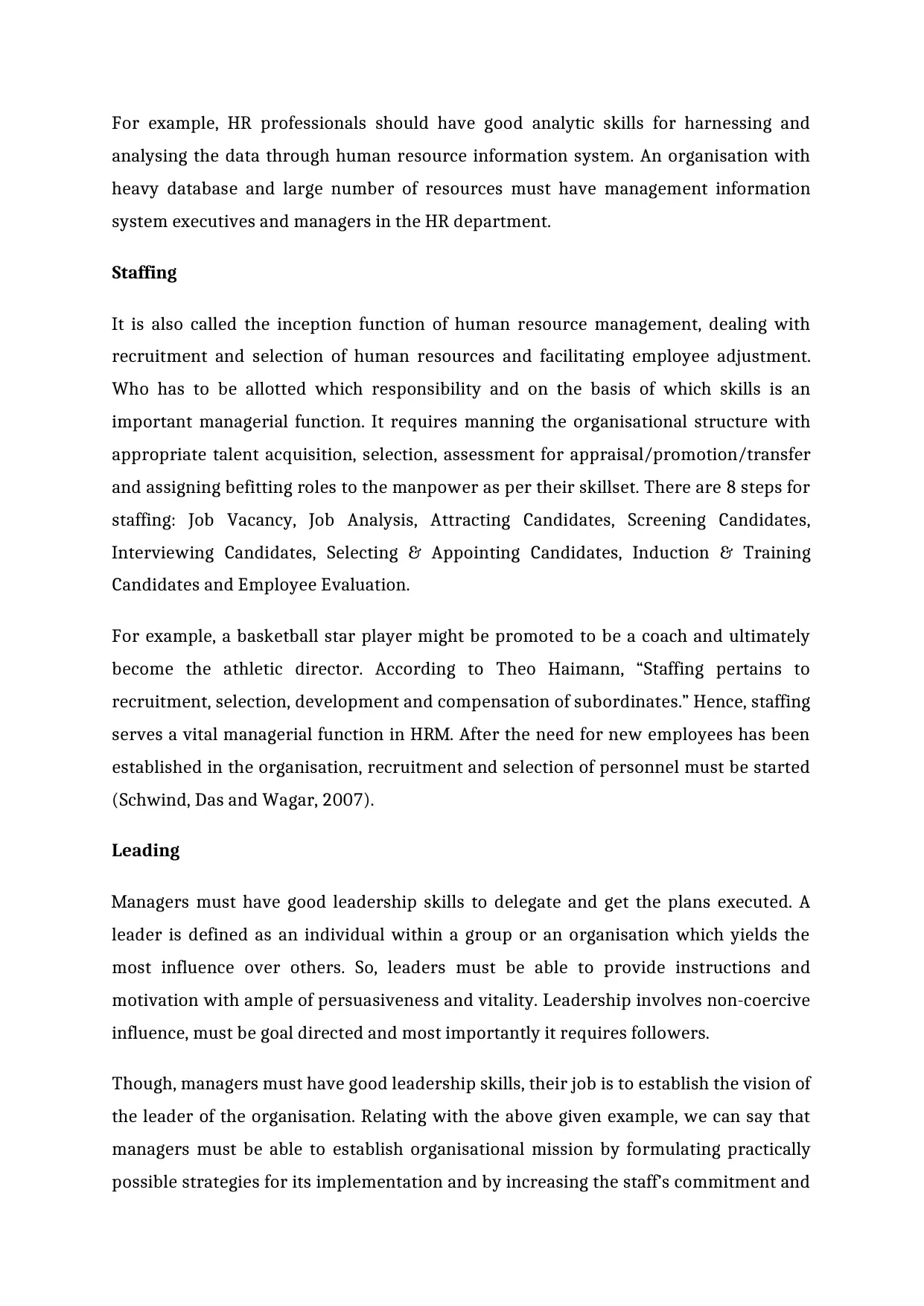
For example, HR professionals should have good analytic skills for harnessing and
analysing the data through human resource information system. An organisation with
heavy database and large number of resources must have management information
system executives and managers in the HR department.
Staffing
It is also called the inception function of human resource management, dealing with
recruitment and selection of human resources and facilitating employee adjustment.
Who has to be allotted which responsibility and on the basis of which skills is an
important managerial function. It requires manning the organisational structure with
appropriate talent acquisition, selection, assessment for appraisal/promotion/transfer
and assigning befitting roles to the manpower as per their skillset. There are 8 steps for
staffing: Job Vacancy, Job Analysis, Attracting Candidates, Screening Candidates,
Interviewing Candidates, Selecting & Appointing Candidates, Induction & Training
Candidates and Employee Evaluation.
For example, a basketball star player might be promoted to be a coach and ultimately
become the athletic director. According to Theo Haimann, “Staffing pertains to
recruitment, selection, development and compensation of subordinates.” Hence, staffing
serves a vital managerial function in HRM. After the need for new employees has been
established in the organisation, recruitment and selection of personnel must be started
(Schwind, Das and Wagar, 2007).
Leading
Managers must have good leadership skills to delegate and get the plans executed. A
leader is defined as an individual within a group or an organisation which yields the
most influence over others. So, leaders must be able to provide instructions and
motivation with ample of persuasiveness and vitality. Leadership involves non-coercive
influence, must be goal directed and most importantly it requires followers.
Though, managers must have good leadership skills, their job is to establish the vision of
the leader of the organisation. Relating with the above given example, we can say that
managers must be able to establish organisational mission by formulating practically
possible strategies for its implementation and by increasing the staff’s commitment and
analysing the data through human resource information system. An organisation with
heavy database and large number of resources must have management information
system executives and managers in the HR department.
Staffing
It is also called the inception function of human resource management, dealing with
recruitment and selection of human resources and facilitating employee adjustment.
Who has to be allotted which responsibility and on the basis of which skills is an
important managerial function. It requires manning the organisational structure with
appropriate talent acquisition, selection, assessment for appraisal/promotion/transfer
and assigning befitting roles to the manpower as per their skillset. There are 8 steps for
staffing: Job Vacancy, Job Analysis, Attracting Candidates, Screening Candidates,
Interviewing Candidates, Selecting & Appointing Candidates, Induction & Training
Candidates and Employee Evaluation.
For example, a basketball star player might be promoted to be a coach and ultimately
become the athletic director. According to Theo Haimann, “Staffing pertains to
recruitment, selection, development and compensation of subordinates.” Hence, staffing
serves a vital managerial function in HRM. After the need for new employees has been
established in the organisation, recruitment and selection of personnel must be started
(Schwind, Das and Wagar, 2007).
Leading
Managers must have good leadership skills to delegate and get the plans executed. A
leader is defined as an individual within a group or an organisation which yields the
most influence over others. So, leaders must be able to provide instructions and
motivation with ample of persuasiveness and vitality. Leadership involves non-coercive
influence, must be goal directed and most importantly it requires followers.
Though, managers must have good leadership skills, their job is to establish the vision of
the leader of the organisation. Relating with the above given example, we can say that
managers must be able to establish organisational mission by formulating practically
possible strategies for its implementation and by increasing the staff’s commitment and
Paraphrase This Document
Need a fresh take? Get an instant paraphrase of this document with our AI Paraphraser
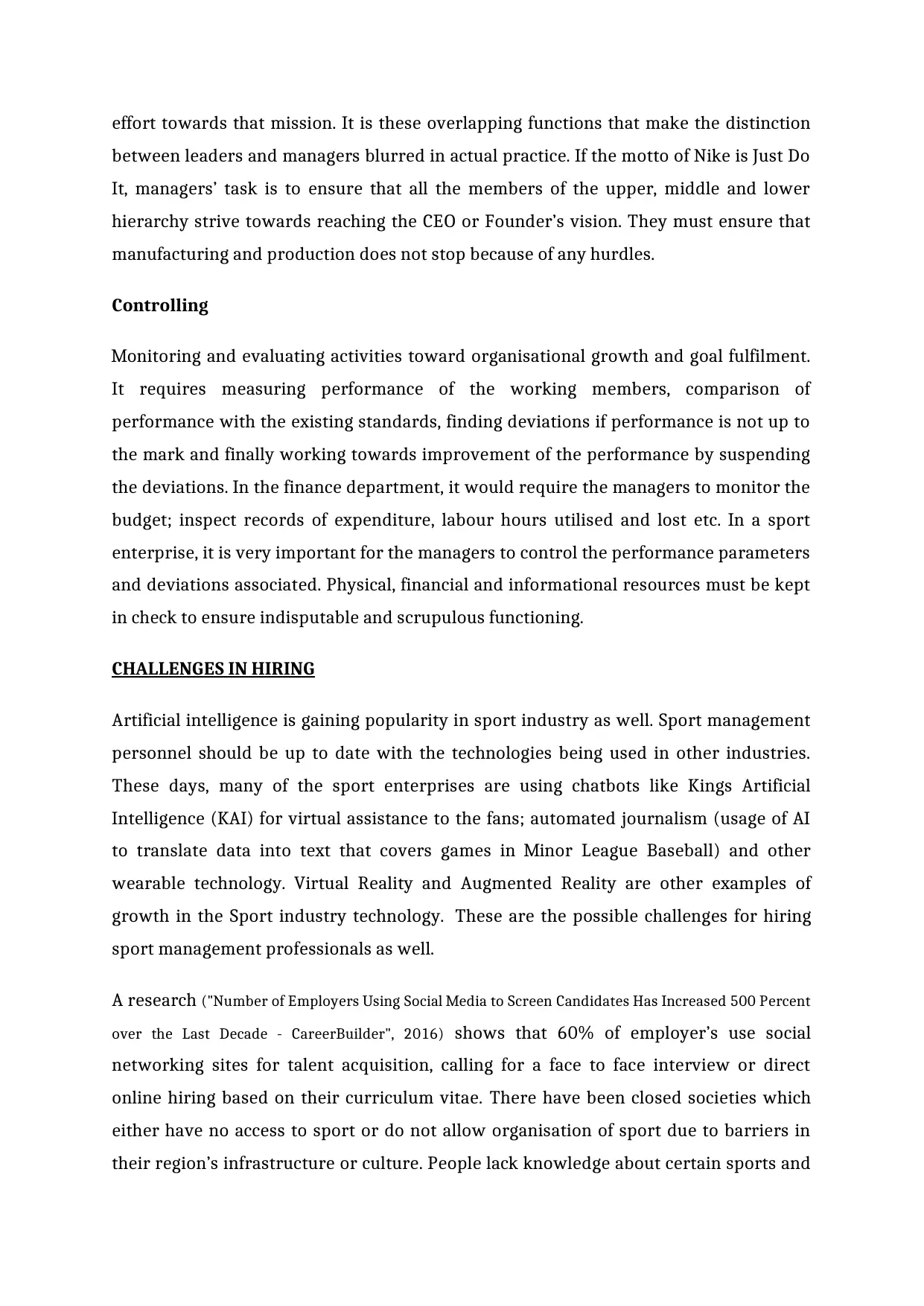
effort towards that mission. It is these overlapping functions that make the distinction
between leaders and managers blurred in actual practice. If the motto of Nike is Just Do
It, managers’ task is to ensure that all the members of the upper, middle and lower
hierarchy strive towards reaching the CEO or Founder’s vision. They must ensure that
manufacturing and production does not stop because of any hurdles.
Controlling
Monitoring and evaluating activities toward organisational growth and goal fulfilment.
It requires measuring performance of the working members, comparison of
performance with the existing standards, finding deviations if performance is not up to
the mark and finally working towards improvement of the performance by suspending
the deviations. In the finance department, it would require the managers to monitor the
budget; inspect records of expenditure, labour hours utilised and lost etc. In a sport
enterprise, it is very important for the managers to control the performance parameters
and deviations associated. Physical, financial and informational resources must be kept
in check to ensure indisputable and scrupulous functioning.
CHALLENGES IN HIRING
Artificial intelligence is gaining popularity in sport industry as well. Sport management
personnel should be up to date with the technologies being used in other industries.
These days, many of the sport enterprises are using chatbots like Kings Artificial
Intelligence (KAI) for virtual assistance to the fans; automated journalism (usage of AI
to translate data into text that covers games in Minor League Baseball) and other
wearable technology. Virtual Reality and Augmented Reality are other examples of
growth in the Sport industry technology. These are the possible challenges for hiring
sport management professionals as well.
A research ("Number of Employers Using Social Media to Screen Candidates Has Increased 500 Percent
over the Last Decade - CareerBuilder", 2016) shows that 60% of employer’s use social
networking sites for talent acquisition, calling for a face to face interview or direct
online hiring based on their curriculum vitae. There have been closed societies which
either have no access to sport or do not allow organisation of sport due to barriers in
their region’s infrastructure or culture. People lack knowledge about certain sports and
between leaders and managers blurred in actual practice. If the motto of Nike is Just Do
It, managers’ task is to ensure that all the members of the upper, middle and lower
hierarchy strive towards reaching the CEO or Founder’s vision. They must ensure that
manufacturing and production does not stop because of any hurdles.
Controlling
Monitoring and evaluating activities toward organisational growth and goal fulfilment.
It requires measuring performance of the working members, comparison of
performance with the existing standards, finding deviations if performance is not up to
the mark and finally working towards improvement of the performance by suspending
the deviations. In the finance department, it would require the managers to monitor the
budget; inspect records of expenditure, labour hours utilised and lost etc. In a sport
enterprise, it is very important for the managers to control the performance parameters
and deviations associated. Physical, financial and informational resources must be kept
in check to ensure indisputable and scrupulous functioning.
CHALLENGES IN HIRING
Artificial intelligence is gaining popularity in sport industry as well. Sport management
personnel should be up to date with the technologies being used in other industries.
These days, many of the sport enterprises are using chatbots like Kings Artificial
Intelligence (KAI) for virtual assistance to the fans; automated journalism (usage of AI
to translate data into text that covers games in Minor League Baseball) and other
wearable technology. Virtual Reality and Augmented Reality are other examples of
growth in the Sport industry technology. These are the possible challenges for hiring
sport management professionals as well.
A research ("Number of Employers Using Social Media to Screen Candidates Has Increased 500 Percent
over the Last Decade - CareerBuilder", 2016) shows that 60% of employer’s use social
networking sites for talent acquisition, calling for a face to face interview or direct
online hiring based on their curriculum vitae. There have been closed societies which
either have no access to sport or do not allow organisation of sport due to barriers in
their region’s infrastructure or culture. People lack knowledge about certain sports and
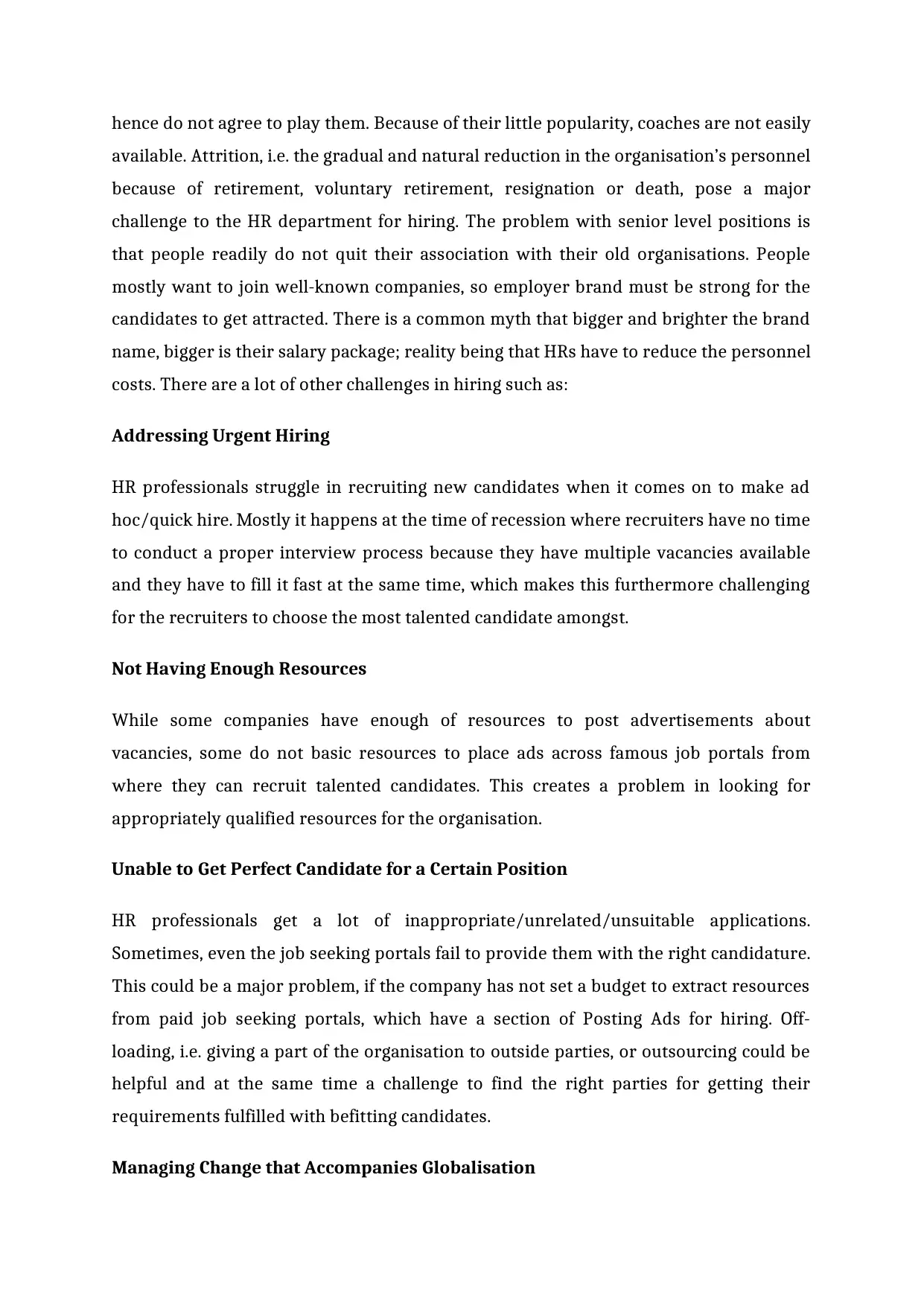
hence do not agree to play them. Because of their little popularity, coaches are not easily
available. Attrition, i.e. the gradual and natural reduction in the organisation’s personnel
because of retirement, voluntary retirement, resignation or death, pose a major
challenge to the HR department for hiring. The problem with senior level positions is
that people readily do not quit their association with their old organisations. People
mostly want to join well-known companies, so employer brand must be strong for the
candidates to get attracted. There is a common myth that bigger and brighter the brand
name, bigger is their salary package; reality being that HRs have to reduce the personnel
costs. There are a lot of other challenges in hiring such as:
Addressing Urgent Hiring
HR professionals struggle in recruiting new candidates when it comes on to make ad
hoc/quick hire. Mostly it happens at the time of recession where recruiters have no time
to conduct a proper interview process because they have multiple vacancies available
and they have to fill it fast at the same time, which makes this furthermore challenging
for the recruiters to choose the most talented candidate amongst.
Not Having Enough Resources
While some companies have enough of resources to post advertisements about
vacancies, some do not basic resources to place ads across famous job portals from
where they can recruit talented candidates. This creates a problem in looking for
appropriately qualified resources for the organisation.
Unable to Get Perfect Candidate for a Certain Position
HR professionals get a lot of inappropriate/unrelated/unsuitable applications.
Sometimes, even the job seeking portals fail to provide them with the right candidature.
This could be a major problem, if the company has not set a budget to extract resources
from paid job seeking portals, which have a section of Posting Ads for hiring. Off-
loading, i.e. giving a part of the organisation to outside parties, or outsourcing could be
helpful and at the same time a challenge to find the right parties for getting their
requirements fulfilled with befitting candidates.
Managing Change that Accompanies Globalisation
available. Attrition, i.e. the gradual and natural reduction in the organisation’s personnel
because of retirement, voluntary retirement, resignation or death, pose a major
challenge to the HR department for hiring. The problem with senior level positions is
that people readily do not quit their association with their old organisations. People
mostly want to join well-known companies, so employer brand must be strong for the
candidates to get attracted. There is a common myth that bigger and brighter the brand
name, bigger is their salary package; reality being that HRs have to reduce the personnel
costs. There are a lot of other challenges in hiring such as:
Addressing Urgent Hiring
HR professionals struggle in recruiting new candidates when it comes on to make ad
hoc/quick hire. Mostly it happens at the time of recession where recruiters have no time
to conduct a proper interview process because they have multiple vacancies available
and they have to fill it fast at the same time, which makes this furthermore challenging
for the recruiters to choose the most talented candidate amongst.
Not Having Enough Resources
While some companies have enough of resources to post advertisements about
vacancies, some do not basic resources to place ads across famous job portals from
where they can recruit talented candidates. This creates a problem in looking for
appropriately qualified resources for the organisation.
Unable to Get Perfect Candidate for a Certain Position
HR professionals get a lot of inappropriate/unrelated/unsuitable applications.
Sometimes, even the job seeking portals fail to provide them with the right candidature.
This could be a major problem, if the company has not set a budget to extract resources
from paid job seeking portals, which have a section of Posting Ads for hiring. Off-
loading, i.e. giving a part of the organisation to outside parties, or outsourcing could be
helpful and at the same time a challenge to find the right parties for getting their
requirements fulfilled with befitting candidates.
Managing Change that Accompanies Globalisation
⊘ This is a preview!⊘
Do you want full access?
Subscribe today to unlock all pages.

Trusted by 1+ million students worldwide
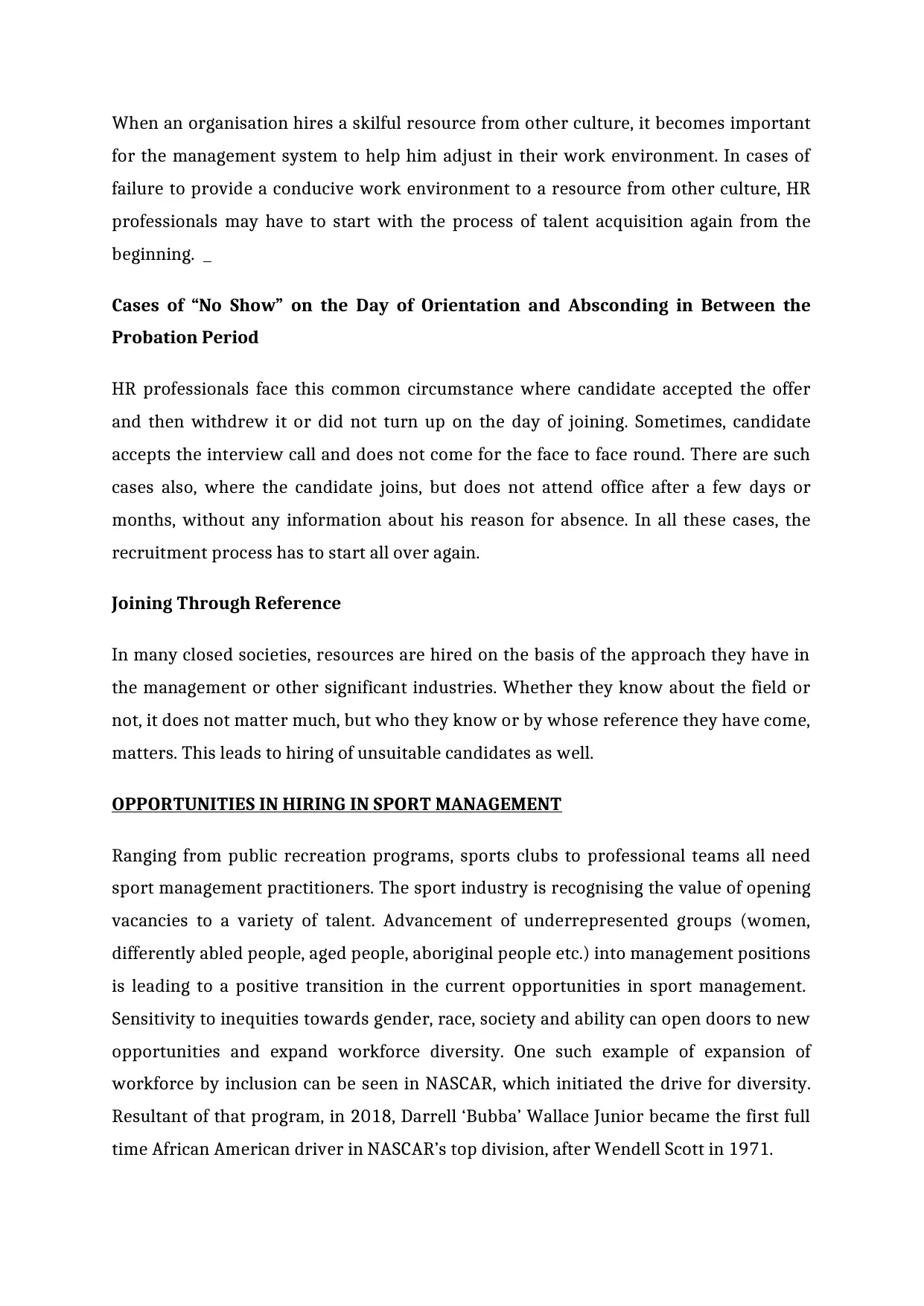
When an organisation hires a skilful resource from other culture, it becomes important
for the management system to help him adjust in their work environment. In cases of
failure to provide a conducive work environment to a resource from other culture, HR
professionals may have to start with the process of talent acquisition again from the
beginning.
Cases of “No Show” on the Day of Orientation and Absconding in Between the
Probation Period
HR professionals face this common circumstance where candidate accepted the offer
and then withdrew it or did not turn up on the day of joining. Sometimes, candidate
accepts the interview call and does not come for the face to face round. There are such
cases also, where the candidate joins, but does not attend office after a few days or
months, without any information about his reason for absence. In all these cases, the
recruitment process has to start all over again.
Joining Through Reference
In many closed societies, resources are hired on the basis of the approach they have in
the management or other significant industries. Whether they know about the field or
not, it does not matter much, but who they know or by whose reference they have come,
matters. This leads to hiring of unsuitable candidates as well.
OPPORTUNITIES IN HIRING IN SPORT MANAGEMENT
Ranging from public recreation programs, sports clubs to professional teams all need
sport management practitioners. The sport industry is recognising the value of opening
vacancies to a variety of talent. Advancement of underrepresented groups (women,
differently abled people, aged people, aboriginal people etc.) into management positions
is leading to a positive transition in the current opportunities in sport management.
Sensitivity to inequities towards gender, race, society and ability can open doors to new
opportunities and expand workforce diversity. One such example of expansion of
workforce by inclusion can be seen in NASCAR, which initiated the drive for diversity.
Resultant of that program, in 2018, Darrell ‘Bubba’ Wallace Junior became the first full
time African American driver in NASCAR’s top division, after Wendell Scott in 1971.
for the management system to help him adjust in their work environment. In cases of
failure to provide a conducive work environment to a resource from other culture, HR
professionals may have to start with the process of talent acquisition again from the
beginning.
Cases of “No Show” on the Day of Orientation and Absconding in Between the
Probation Period
HR professionals face this common circumstance where candidate accepted the offer
and then withdrew it or did not turn up on the day of joining. Sometimes, candidate
accepts the interview call and does not come for the face to face round. There are such
cases also, where the candidate joins, but does not attend office after a few days or
months, without any information about his reason for absence. In all these cases, the
recruitment process has to start all over again.
Joining Through Reference
In many closed societies, resources are hired on the basis of the approach they have in
the management or other significant industries. Whether they know about the field or
not, it does not matter much, but who they know or by whose reference they have come,
matters. This leads to hiring of unsuitable candidates as well.
OPPORTUNITIES IN HIRING IN SPORT MANAGEMENT
Ranging from public recreation programs, sports clubs to professional teams all need
sport management practitioners. The sport industry is recognising the value of opening
vacancies to a variety of talent. Advancement of underrepresented groups (women,
differently abled people, aged people, aboriginal people etc.) into management positions
is leading to a positive transition in the current opportunities in sport management.
Sensitivity to inequities towards gender, race, society and ability can open doors to new
opportunities and expand workforce diversity. One such example of expansion of
workforce by inclusion can be seen in NASCAR, which initiated the drive for diversity.
Resultant of that program, in 2018, Darrell ‘Bubba’ Wallace Junior became the first full
time African American driver in NASCAR’s top division, after Wendell Scott in 1971.
Paraphrase This Document
Need a fresh take? Get an instant paraphrase of this document with our AI Paraphraser

Pederson and colleagues (2017) noted that business of sport continues to expand and
with the rapid growth of the industry, there is seemingly unending growth in the value
of sport as a commodity. There are new up surging opportunities impending in the
sport industry such as participation as a player, umpire or coach; scholarly publications;
social media and mass media for sourcing publicity of events and players; sport
tourism; adventure sport travel; goods and services; sport funding and promoting
enterprises. With marketing and promotion orientation’s growth, sport managers are
becoming more competent and globalisation of sport is becoming rapid. Endorsements
and sponsorships are on the rise, with educational institutions giving relevance to sport
industry.
Diversity
HR professionals have to recruit regardless of the region or culture. They have to
maintain diversity at their workplace such that anytime during the business dealings or
any other communications, they won’t get stuck. Diverse staff also ensures creativity at
work and increases level of efficiency.
Innovation
It is important to identify candidates who can introduce creative and innovative
elements to the existing procedures. They are efficient workers who can help in
launching an altogether new product in the industry. They can also help in removing
monotony at workplace.
Ethical & Legal Requirements
Recruiter should provide knowledge of all the ethical and legal requirements of the
organisation, in order to keep transparency between organisation and the candidate.
Talent Identification
with the rapid growth of the industry, there is seemingly unending growth in the value
of sport as a commodity. There are new up surging opportunities impending in the
sport industry such as participation as a player, umpire or coach; scholarly publications;
social media and mass media for sourcing publicity of events and players; sport
tourism; adventure sport travel; goods and services; sport funding and promoting
enterprises. With marketing and promotion orientation’s growth, sport managers are
becoming more competent and globalisation of sport is becoming rapid. Endorsements
and sponsorships are on the rise, with educational institutions giving relevance to sport
industry.
Diversity
HR professionals have to recruit regardless of the region or culture. They have to
maintain diversity at their workplace such that anytime during the business dealings or
any other communications, they won’t get stuck. Diverse staff also ensures creativity at
work and increases level of efficiency.
Innovation
It is important to identify candidates who can introduce creative and innovative
elements to the existing procedures. They are efficient workers who can help in
launching an altogether new product in the industry. They can also help in removing
monotony at workplace.
Ethical & Legal Requirements
Recruiter should provide knowledge of all the ethical and legal requirements of the
organisation, in order to keep transparency between organisation and the candidate.
Talent Identification
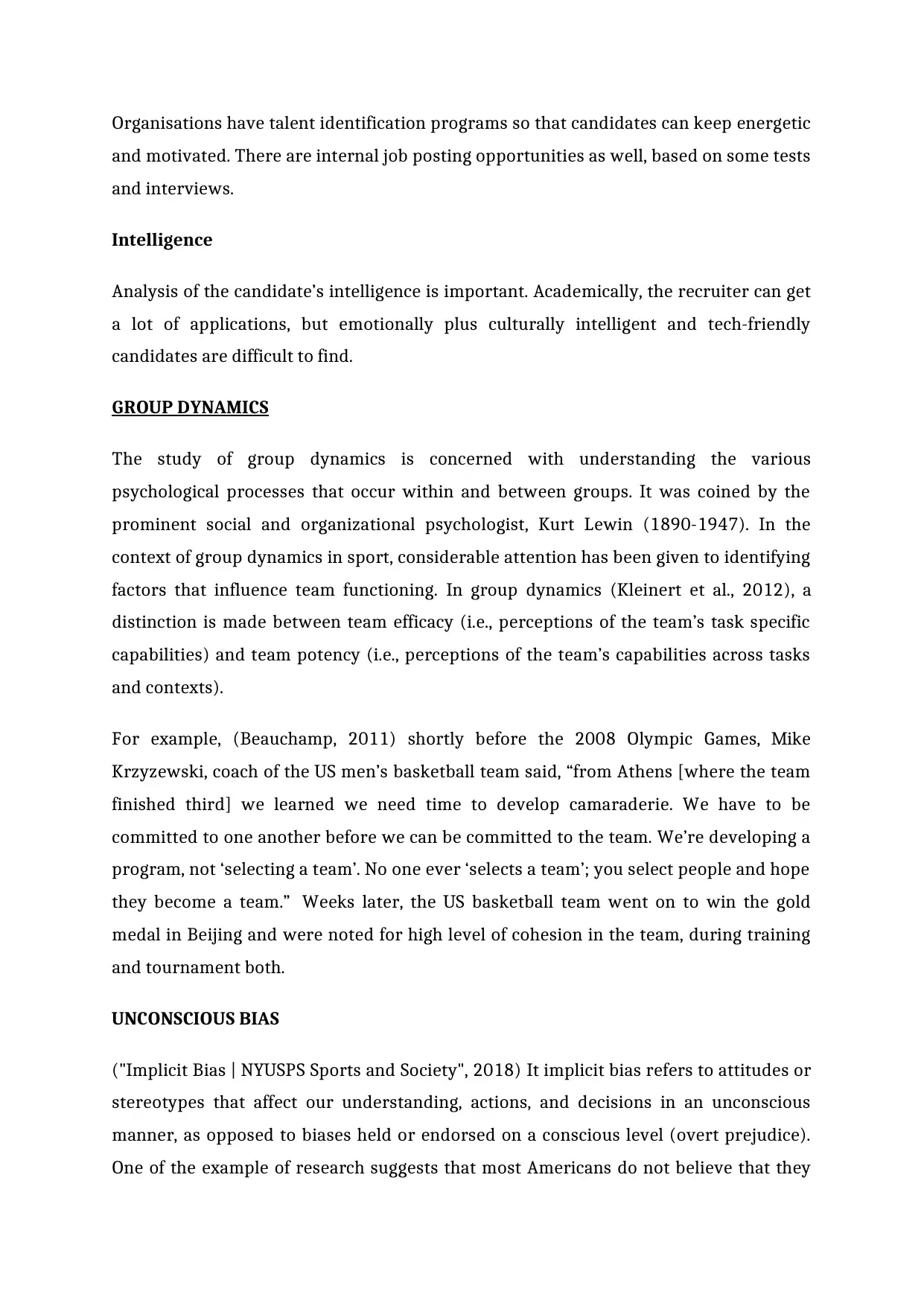
Organisations have talent identification programs so that candidates can keep energetic
and motivated. There are internal job posting opportunities as well, based on some tests
and interviews.
Intelligence
Analysis of the candidate’s intelligence is important. Academically, the recruiter can get
a lot of applications, but emotionally plus culturally intelligent and tech-friendly
candidates are difficult to find.
GROUP DYNAMICS
The study of group dynamics is concerned with understanding the various
psychological processes that occur within and between groups. It was coined by the
prominent social and organizational psychologist, Kurt Lewin (1890-1947). In the
context of group dynamics in sport, considerable attention has been given to identifying
factors that influence team functioning. In group dynamics (Kleinert et al., 2012), a
distinction is made between team efficacy (i.e., perceptions of the team’s task specific
capabilities) and team potency (i.e., perceptions of the team’s capabilities across tasks
and contexts).
For example, (Beauchamp, 2011) shortly before the 2008 Olympic Games, Mike
Krzyzewski, coach of the US men’s basketball team said, “from Athens [where the team
finished third] we learned we need time to develop camaraderie. We have to be
committed to one another before we can be committed to the team. We’re developing a
program, not ‘selecting a team’. No one ever ‘selects a team’; you select people and hope
they become a team.” Weeks later, the US basketball team went on to win the gold
medal in Beijing and were noted for high level of cohesion in the team, during training
and tournament both.
UNCONSCIOUS BIAS
("Implicit Bias | NYUSPS Sports and Society", 2018) It implicit bias refers to attitudes or
stereotypes that affect our understanding, actions, and decisions in an unconscious
manner, as opposed to biases held or endorsed on a conscious level (overt prejudice).
One of the example of research suggests that most Americans do not believe that they
and motivated. There are internal job posting opportunities as well, based on some tests
and interviews.
Intelligence
Analysis of the candidate’s intelligence is important. Academically, the recruiter can get
a lot of applications, but emotionally plus culturally intelligent and tech-friendly
candidates are difficult to find.
GROUP DYNAMICS
The study of group dynamics is concerned with understanding the various
psychological processes that occur within and between groups. It was coined by the
prominent social and organizational psychologist, Kurt Lewin (1890-1947). In the
context of group dynamics in sport, considerable attention has been given to identifying
factors that influence team functioning. In group dynamics (Kleinert et al., 2012), a
distinction is made between team efficacy (i.e., perceptions of the team’s task specific
capabilities) and team potency (i.e., perceptions of the team’s capabilities across tasks
and contexts).
For example, (Beauchamp, 2011) shortly before the 2008 Olympic Games, Mike
Krzyzewski, coach of the US men’s basketball team said, “from Athens [where the team
finished third] we learned we need time to develop camaraderie. We have to be
committed to one another before we can be committed to the team. We’re developing a
program, not ‘selecting a team’. No one ever ‘selects a team’; you select people and hope
they become a team.” Weeks later, the US basketball team went on to win the gold
medal in Beijing and were noted for high level of cohesion in the team, during training
and tournament both.
UNCONSCIOUS BIAS
("Implicit Bias | NYUSPS Sports and Society", 2018) It implicit bias refers to attitudes or
stereotypes that affect our understanding, actions, and decisions in an unconscious
manner, as opposed to biases held or endorsed on a conscious level (overt prejudice).
One of the example of research suggests that most Americans do not believe that they
⊘ This is a preview!⊘
Do you want full access?
Subscribe today to unlock all pages.

Trusted by 1+ million students worldwide
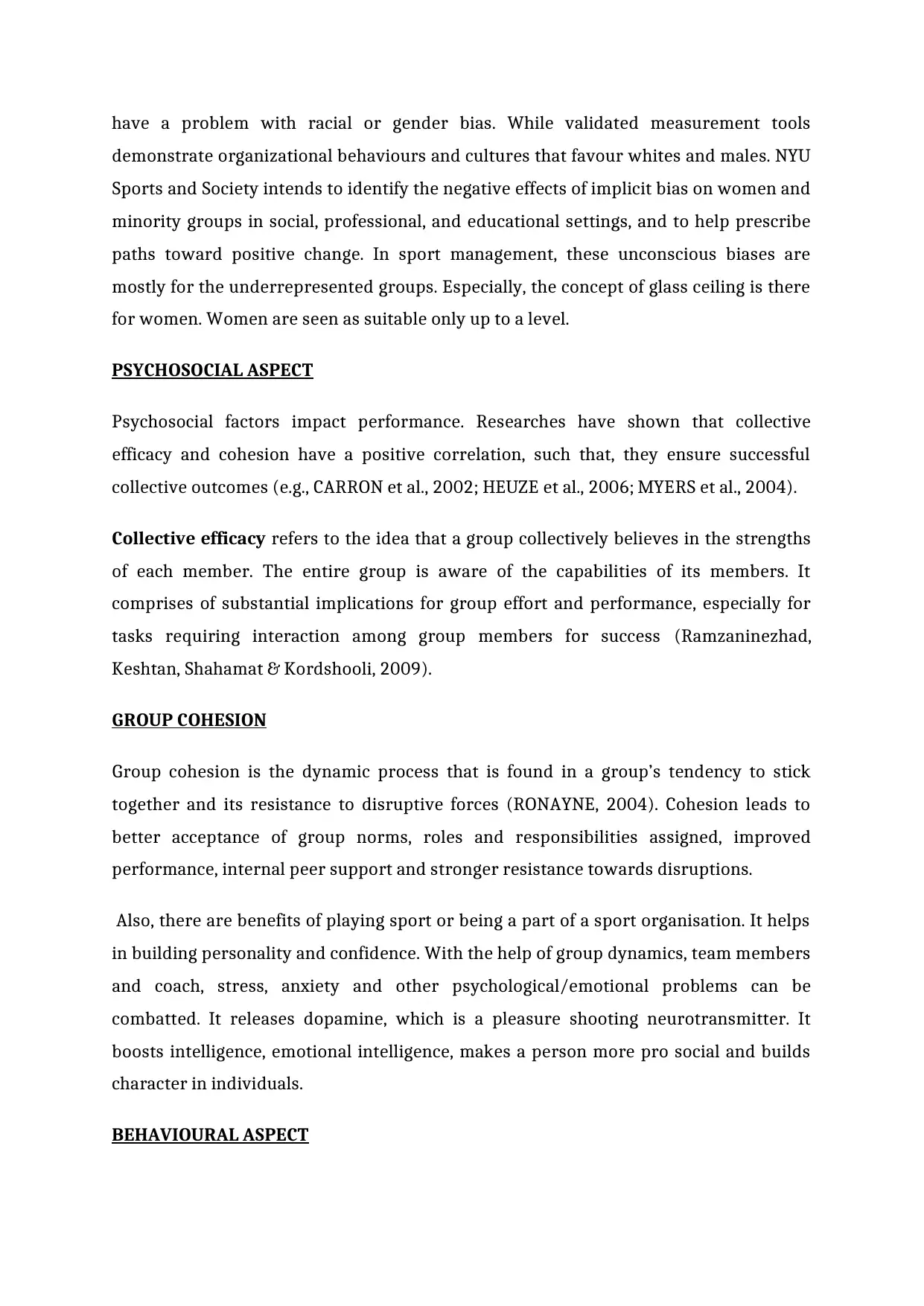
have a problem with racial or gender bias. While validated measurement tools
demonstrate organizational behaviours and cultures that favour whites and males. NYU
Sports and Society intends to identify the negative effects of implicit bias on women and
minority groups in social, professional, and educational settings, and to help prescribe
paths toward positive change. In sport management, these unconscious biases are
mostly for the underrepresented groups. Especially, the concept of glass ceiling is there
for women. Women are seen as suitable only up to a level.
PSYCHOSOCIAL ASPECT
Psychosocial factors impact performance. Researches have shown that collective
efficacy and cohesion have a positive correlation, such that, they ensure successful
collective outcomes (e.g., CARRON et al., 2002; HEUZE et al., 2006; MYERS et al., 2004).
Collective efficacy refers to the idea that a group collectively believes in the strengths
of each member. The entire group is aware of the capabilities of its members. It
comprises of substantial implications for group effort and performance, especially for
tasks requiring interaction among group members for success (Ramzaninezhad,
Keshtan, Shahamat & Kordshooli, 2009).
GROUP COHESION
Group cohesion is the dynamic process that is found in a group’s tendency to stick
together and its resistance to disruptive forces (RONAYNE, 2004). Cohesion leads to
better acceptance of group norms, roles and responsibilities assigned, improved
performance, internal peer support and stronger resistance towards disruptions.
Also, there are benefits of playing sport or being a part of a sport organisation. It helps
in building personality and confidence. With the help of group dynamics, team members
and coach, stress, anxiety and other psychological/emotional problems can be
combatted. It releases dopamine, which is a pleasure shooting neurotransmitter. It
boosts intelligence, emotional intelligence, makes a person more pro social and builds
character in individuals.
BEHAVIOURAL ASPECT
demonstrate organizational behaviours and cultures that favour whites and males. NYU
Sports and Society intends to identify the negative effects of implicit bias on women and
minority groups in social, professional, and educational settings, and to help prescribe
paths toward positive change. In sport management, these unconscious biases are
mostly for the underrepresented groups. Especially, the concept of glass ceiling is there
for women. Women are seen as suitable only up to a level.
PSYCHOSOCIAL ASPECT
Psychosocial factors impact performance. Researches have shown that collective
efficacy and cohesion have a positive correlation, such that, they ensure successful
collective outcomes (e.g., CARRON et al., 2002; HEUZE et al., 2006; MYERS et al., 2004).
Collective efficacy refers to the idea that a group collectively believes in the strengths
of each member. The entire group is aware of the capabilities of its members. It
comprises of substantial implications for group effort and performance, especially for
tasks requiring interaction among group members for success (Ramzaninezhad,
Keshtan, Shahamat & Kordshooli, 2009).
GROUP COHESION
Group cohesion is the dynamic process that is found in a group’s tendency to stick
together and its resistance to disruptive forces (RONAYNE, 2004). Cohesion leads to
better acceptance of group norms, roles and responsibilities assigned, improved
performance, internal peer support and stronger resistance towards disruptions.
Also, there are benefits of playing sport or being a part of a sport organisation. It helps
in building personality and confidence. With the help of group dynamics, team members
and coach, stress, anxiety and other psychological/emotional problems can be
combatted. It releases dopamine, which is a pleasure shooting neurotransmitter. It
boosts intelligence, emotional intelligence, makes a person more pro social and builds
character in individuals.
BEHAVIOURAL ASPECT
Paraphrase This Document
Need a fresh take? Get an instant paraphrase of this document with our AI Paraphraser
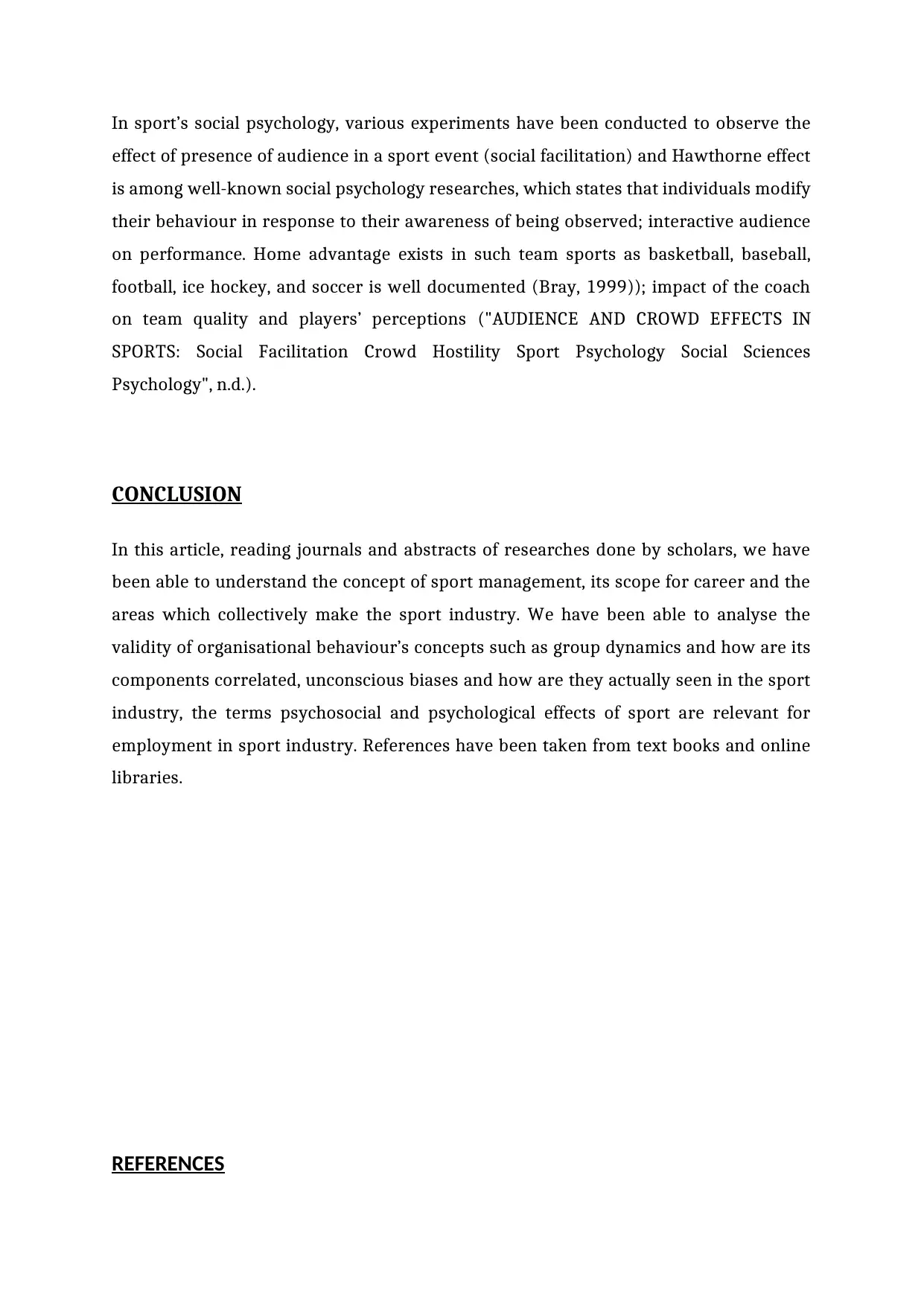
In sport’s social psychology, various experiments have been conducted to observe the
effect of presence of audience in a sport event (social facilitation) and Hawthorne effect
is among well-known social psychology researches, which states that individuals modify
their behaviour in response to their awareness of being observed; interactive audience
on performance. Home advantage exists in such team sports as basketball, baseball,
football, ice hockey, and soccer is well documented (Bray, 1999)); impact of the coach
on team quality and players’ perceptions ("AUDIENCE AND CROWD EFFECTS IN
SPORTS: Social Facilitation Crowd Hostility Sport Psychology Social Sciences
Psychology", n.d.).
CONCLUSION
In this article, reading journals and abstracts of researches done by scholars, we have
been able to understand the concept of sport management, its scope for career and the
areas which collectively make the sport industry. We have been able to analyse the
validity of organisational behaviour’s concepts such as group dynamics and how are its
components correlated, unconscious biases and how are they actually seen in the sport
industry, the terms psychosocial and psychological effects of sport are relevant for
employment in sport industry. References have been taken from text books and online
libraries.
REFERENCES
effect of presence of audience in a sport event (social facilitation) and Hawthorne effect
is among well-known social psychology researches, which states that individuals modify
their behaviour in response to their awareness of being observed; interactive audience
on performance. Home advantage exists in such team sports as basketball, baseball,
football, ice hockey, and soccer is well documented (Bray, 1999)); impact of the coach
on team quality and players’ perceptions ("AUDIENCE AND CROWD EFFECTS IN
SPORTS: Social Facilitation Crowd Hostility Sport Psychology Social Sciences
Psychology", n.d.).
CONCLUSION
In this article, reading journals and abstracts of researches done by scholars, we have
been able to understand the concept of sport management, its scope for career and the
areas which collectively make the sport industry. We have been able to analyse the
validity of organisational behaviour’s concepts such as group dynamics and how are its
components correlated, unconscious biases and how are they actually seen in the sport
industry, the terms psychosocial and psychological effects of sport are relevant for
employment in sport industry. References have been taken from text books and online
libraries.
REFERENCES
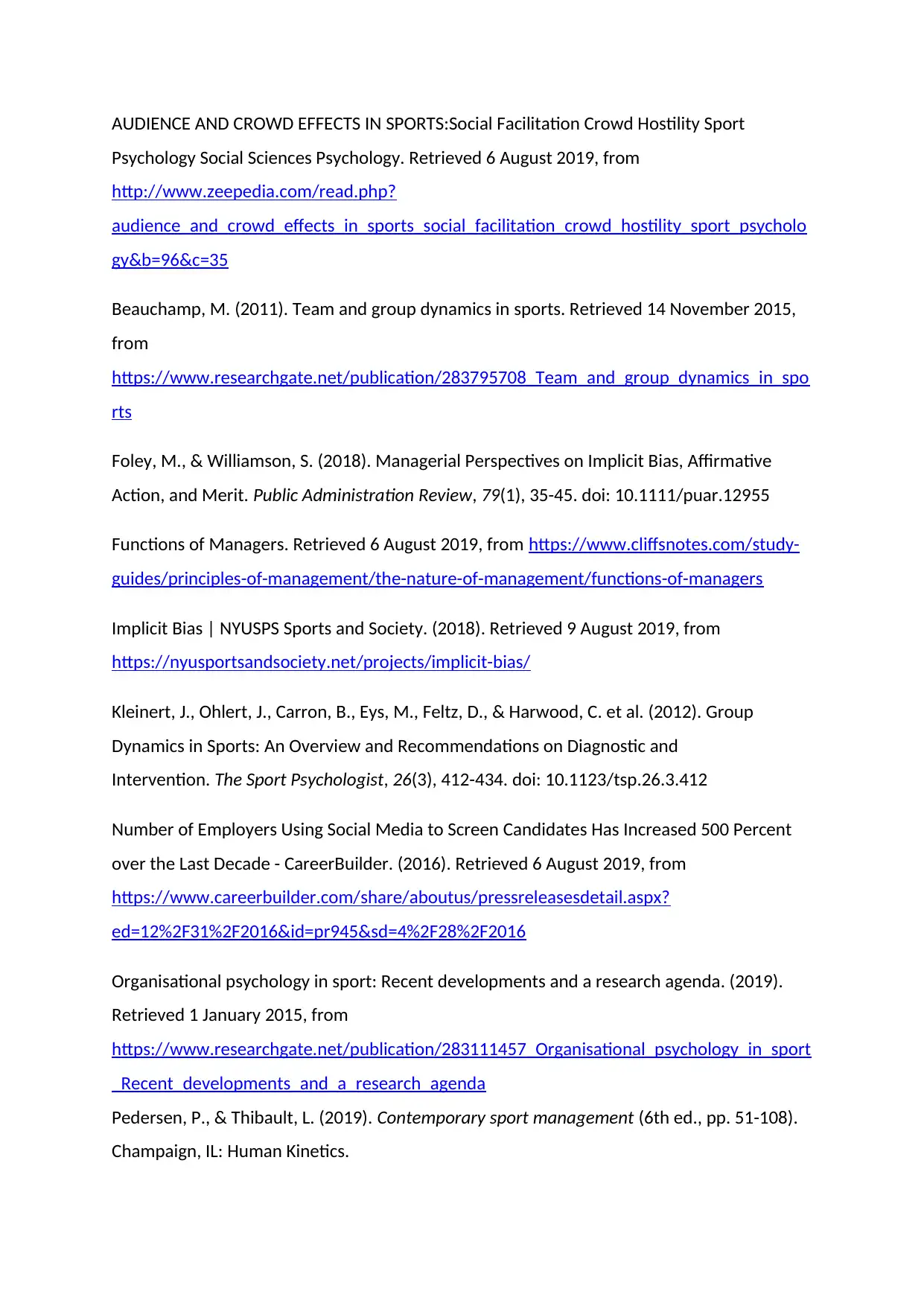
AUDIENCE AND CROWD EFFECTS IN SPORTS:Social Facilitation Crowd Hostility Sport
Psychology Social Sciences Psychology. Retrieved 6 August 2019, from
http://www.zeepedia.com/read.php?
audience_and_crowd_effects_in_sports_social_facilitation_crowd_hostility_sport_psycholo
gy&b=96&c=35
Beauchamp, M. (2011). Team and group dynamics in sports. Retrieved 14 November 2015,
from
https://www.researchgate.net/publication/283795708_Team_and_group_dynamics_in_spo
rts
Foley, M., & Williamson, S. (2018). Managerial Perspectives on Implicit Bias, Affirmative
Action, and Merit. Public Administration Review, 79(1), 35-45. doi: 10.1111/puar.12955
Functions of Managers. Retrieved 6 August 2019, from https://www.cliffsnotes.com/study-
guides/principles-of-management/the-nature-of-management/functions-of-managers
Implicit Bias | NYUSPS Sports and Society. (2018). Retrieved 9 August 2019, from
https://nyusportsandsociety.net/projects/implicit-bias/
Kleinert, J., Ohlert, J., Carron, B., Eys, M., Feltz, D., & Harwood, C. et al. (2012). Group
Dynamics in Sports: An Overview and Recommendations on Diagnostic and
Intervention. The Sport Psychologist, 26(3), 412-434. doi: 10.1123/tsp.26.3.412
Number of Employers Using Social Media to Screen Candidates Has Increased 500 Percent
over the Last Decade - CareerBuilder. (2016). Retrieved 6 August 2019, from
https://www.careerbuilder.com/share/aboutus/pressreleasesdetail.aspx?
ed=12%2F31%2F2016&id=pr945&sd=4%2F28%2F2016
Organisational psychology in sport: Recent developments and a research agenda. (2019).
Retrieved 1 January 2015, from
https://www.researchgate.net/publication/283111457_Organisational_psychology_in_sport
_Recent_developments_and_a_research_agenda
Pedersen, P., & Thibault, L. (2019). Contemporary sport management (6th ed., pp. 51-108).
Champaign, IL: Human Kinetics.
Psychology Social Sciences Psychology. Retrieved 6 August 2019, from
http://www.zeepedia.com/read.php?
audience_and_crowd_effects_in_sports_social_facilitation_crowd_hostility_sport_psycholo
gy&b=96&c=35
Beauchamp, M. (2011). Team and group dynamics in sports. Retrieved 14 November 2015,
from
https://www.researchgate.net/publication/283795708_Team_and_group_dynamics_in_spo
rts
Foley, M., & Williamson, S. (2018). Managerial Perspectives on Implicit Bias, Affirmative
Action, and Merit. Public Administration Review, 79(1), 35-45. doi: 10.1111/puar.12955
Functions of Managers. Retrieved 6 August 2019, from https://www.cliffsnotes.com/study-
guides/principles-of-management/the-nature-of-management/functions-of-managers
Implicit Bias | NYUSPS Sports and Society. (2018). Retrieved 9 August 2019, from
https://nyusportsandsociety.net/projects/implicit-bias/
Kleinert, J., Ohlert, J., Carron, B., Eys, M., Feltz, D., & Harwood, C. et al. (2012). Group
Dynamics in Sports: An Overview and Recommendations on Diagnostic and
Intervention. The Sport Psychologist, 26(3), 412-434. doi: 10.1123/tsp.26.3.412
Number of Employers Using Social Media to Screen Candidates Has Increased 500 Percent
over the Last Decade - CareerBuilder. (2016). Retrieved 6 August 2019, from
https://www.careerbuilder.com/share/aboutus/pressreleasesdetail.aspx?
ed=12%2F31%2F2016&id=pr945&sd=4%2F28%2F2016
Organisational psychology in sport: Recent developments and a research agenda. (2019).
Retrieved 1 January 2015, from
https://www.researchgate.net/publication/283111457_Organisational_psychology_in_sport
_Recent_developments_and_a_research_agenda
Pedersen, P., & Thibault, L. (2019). Contemporary sport management (6th ed., pp. 51-108).
Champaign, IL: Human Kinetics.
⊘ This is a preview!⊘
Do you want full access?
Subscribe today to unlock all pages.

Trusted by 1+ million students worldwide
1 out of 13
Related Documents
Your All-in-One AI-Powered Toolkit for Academic Success.
+13062052269
info@desklib.com
Available 24*7 on WhatsApp / Email
![[object Object]](/_next/static/media/star-bottom.7253800d.svg)
Unlock your academic potential
Copyright © 2020–2025 A2Z Services. All Rights Reserved. Developed and managed by ZUCOL.





